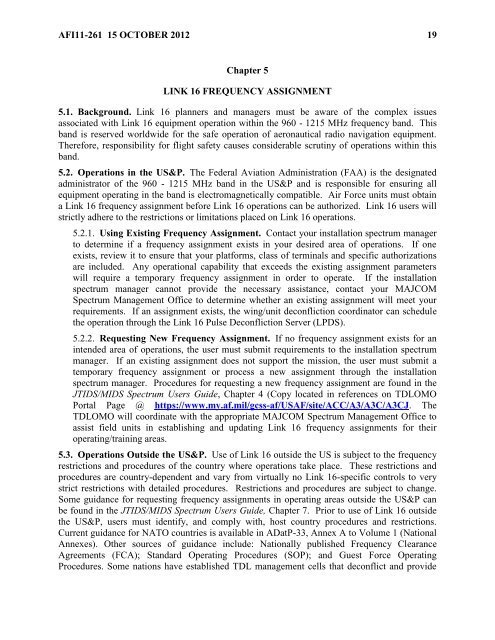By order of the air force instruction 11-261 - Air Force E-Publishing ...
By order of the air force instruction 11-261 - Air Force E-Publishing ...
By order of the air force instruction 11-261 - Air Force E-Publishing ...
You also want an ePaper? Increase the reach of your titles
YUMPU automatically turns print PDFs into web optimized ePapers that Google loves.
AFI<strong>11</strong>-<strong>261</strong> 15 OCTOBER 2012 19<br />
Chapter 5<br />
LINK 16 FREQUENCY ASSIGNMENT<br />
5.1. Background. Link 16 planners and managers must be aware <strong>of</strong> <strong>the</strong> complex issues<br />
associated with Link 16 equipment operation within <strong>the</strong> 960 - 1215 MHz frequency band. This<br />
band is reserved worldwide for <strong>the</strong> safe operation <strong>of</strong> aeronautical radio navigation equipment.<br />
Therefore, responsibility for flight safety causes considerable scrutiny <strong>of</strong> operations within this<br />
band.<br />
5.2. Operations in <strong>the</strong> US&P. The Federal Aviation Administration (FAA) is <strong>the</strong> designated<br />
administrator <strong>of</strong> <strong>the</strong> 960 - 1215 MHz band in <strong>the</strong> US&P and is responsible for ensuring all<br />
equipment operating in <strong>the</strong> band is electromagnetically compatible. <strong>Air</strong> <strong>Force</strong> units must obtain<br />
a Link 16 frequency assignment before Link 16 operations can be authorized. Link 16 users will<br />
strictly adhere to <strong>the</strong> restrictions or limitations placed on Link 16 operations.<br />
5.2.1. Using Existing Frequency Assignment. Contact your installation spectrum manager<br />
to determine if a frequency assignment exists in your desired area <strong>of</strong> operations. If one<br />
exists, review it to ensure that your platforms, class <strong>of</strong> terminals and specific authorizations<br />
are included. Any operational capability that exceeds <strong>the</strong> existing assignment parameters<br />
will require a temporary frequency assignment in <strong>order</strong> to operate. If <strong>the</strong> installation<br />
spectrum manager cannot provide <strong>the</strong> necessary assistance, contact your MAJCOM<br />
Spectrum Management Office to determine whe<strong>the</strong>r an existing assignment will meet your<br />
requirements. If an assignment exists, <strong>the</strong> wing/unit deconfliction coordinator can schedule<br />
<strong>the</strong> operation through <strong>the</strong> Link 16 Pulse Deconfliction Server (LPDS).<br />
5.2.2. Requesting New Frequency Assignment. If no frequency assignment exists for an<br />
intended area <strong>of</strong> operations, <strong>the</strong> user must submit requirements to <strong>the</strong> installation spectrum<br />
manager. If an existing assignment does not support <strong>the</strong> mission, <strong>the</strong> user must submit a<br />
temporary frequency assignment or process a new assignment through <strong>the</strong> installation<br />
spectrum manager. Procedures for requesting a new frequency assignment are found in <strong>the</strong><br />
JTIDS/MIDS Spectrum Users Guide, Chapter 4 (Copy located in references on TDLOMO<br />
Portal Page @ https://www.my.af.mil/gcss-af/USAF/site/ACC/A3/A3C/A3CJ. The<br />
TDLOMO will coordinate with <strong>the</strong> appropriate MAJCOM Spectrum Management Office to<br />
assist field units in establishing and updating Link 16 frequency assignments for <strong>the</strong>ir<br />
operating/training areas.<br />
5.3. Operations Outside <strong>the</strong> US&P. Use <strong>of</strong> Link 16 outside <strong>the</strong> US is subject to <strong>the</strong> frequency<br />
restrictions and procedures <strong>of</strong> <strong>the</strong> country where operations take place. These restrictions and<br />
procedures are country-dependent and vary from virtually no Link 16-specific controls to very<br />
strict restrictions with detailed procedures. Restrictions and procedures are subject to change.<br />
Some guidance for requesting frequency assignments in operating areas outside <strong>the</strong> US&P can<br />
be found in <strong>the</strong> JTIDS/MIDS Spectrum Users Guide, Chapter 7. Prior to use <strong>of</strong> Link 16 outside<br />
<strong>the</strong> US&P, users must identify, and comply with, host country procedures and restrictions.<br />
Current guidance for NATO countries is available in ADatP-33, Annex A to Volume 1 (National<br />
Annexes). O<strong>the</strong>r sources <strong>of</strong> guidance include: Nationally published Frequency Clearance<br />
Agreements (FCA); Standard Operating Procedures (SOP); and Guest <strong>Force</strong> Operating<br />
Procedures. Some nations have established TDL management cells that deconflict and provide
















